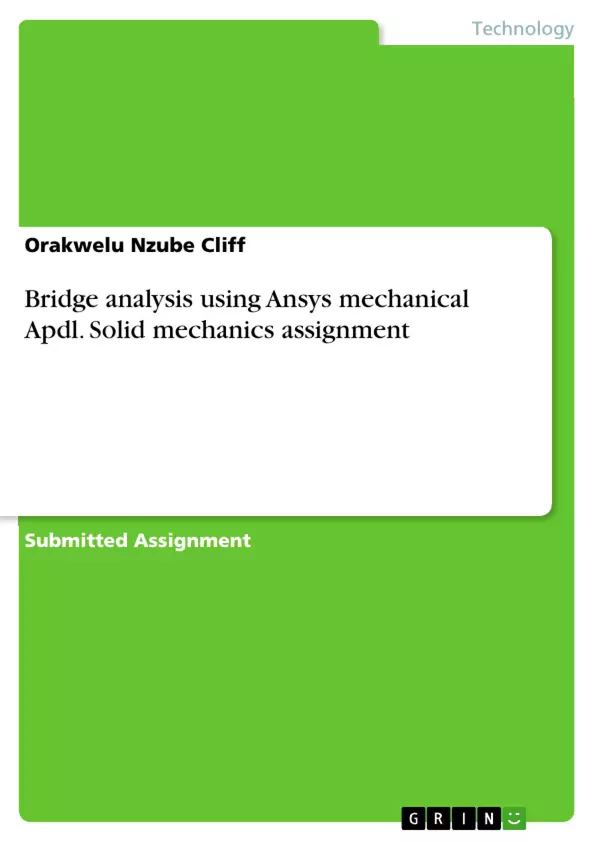This paper is a bridge analysis using Ansys mechanical Apdl. It's a solid mechanics assignment that's solves different tasks regarding the theme.
Inhaltsverzeichnis (Table of Contents)
- TASK 1
- Create and present FE model of the bridge
- 1.10 Creation of the Finite Element model.
- Discuss real constants, material model and element type chosen for the FE analysis
- Task 1.12 Justification of the element type selected
- Task 1.13 Present meshed FE model and discuss the procedures used for it
- Task 1.14 Explain the boundary conditions used for the modal analysis
- Task 1.15 Present your post processing results in textual and graphical form
- Task 1.16 Discuss the solver used for this analysis.
- Task 1.17 Refine the FE model with more elements and conduct analysis
- Task 1.18 Presenting the post processing results in textual and graphical form for the no of element division of 100 for the refined analysis and compare it with the results of previous model.
- Discussion and Conclusion.
Zielsetzung und Themenschwerpunkte (Objectives and Key Themes)
This document aims to create and present a Finite Element (FE) model of a bridge, analyzing its behavior and performance under various conditions. The analysis will be conducted using a 1-Dimensional (1D) approach, focusing on key aspects like material selection, element type, boundary conditions, and post-processing results.
- Creation of a 1D Finite Element model for the bridge.
- Analysis of the bridge's behavior using the FE model.
- Comparison of results for different mesh refinements.
- Discussion of solver performance and post-processing techniques.
- Presentation of the results in textual and graphical forms.
Zusammenfassung der Kapitel (Chapter Summaries)
- TASK 1: Create and present FE model of the bridge: This chapter covers the process of creating a 1D Finite Element model of the bridge, outlining the key steps involved. It discusses the creation of keypoints, the joining of lines to form the bridge, and the choice of material properties and element type.
- Task 1.10: Creation of the Finite Element model: This section explains the process of creating the FE model using keypoint assignment in X, Y, and Z coordinates. It illustrates this process with figures and provides a step-by-step guide.
- Discuss real constants, material model and element type chosen for the FE analysis: This section delves into the rationale behind selecting specific real constants, a material model, and an element type for the FE analysis. It explains how these choices influence the accuracy and effectiveness of the model.
- Task 1.12: Justification of the element type selected: This section provides a thorough explanation of the justification for the chosen element type. It discusses the advantages and limitations of this type in the context of the bridge analysis.
- Task 1.13: Present meshed FE model and discuss the procedures used for it: This section showcases the meshed FE model and outlines the procedures used to generate it. It discusses the meshing process and its importance in FE analysis.
- Task 1.14: Explain the boundary conditions used for the modal analysis: This section explains the boundary conditions applied to the FE model for modal analysis. It discusses the significance of these conditions in determining the bridge's dynamic behavior.
- Task 1.15: Present your post processing results in textual and graphical form: This section focuses on presenting the post-processing results of the FE analysis in both textual and graphical formats. It discusses the methods used to interpret and visualize the results.
- Task 1.16: Discuss the solver used for this analysis: This section provides a discussion of the solver used for the FE analysis, highlighting its features, capabilities, and limitations.
- Task 1.17: Refine the FE model with more elements and conduct analysis: This section explores the process of refining the FE model by increasing the number of elements and conducting a new analysis. It examines the impact of this refinement on the results.
- Task 1.18: Presenting the post processing results in textual and graphical form for the no of element division of 100 for the refined analysis and compare it with the results of previous model: This section presents the post-processing results of the refined analysis, comparing them to the results obtained from the original model. It discusses the significance of these comparisons.
Schlüsselwörter (Keywords)
The key focus topics of this text include finite element analysis (FEA), 1-Dimensional modeling, bridge modeling, material properties, element type selection, mesh refinement, boundary conditions, modal analysis, post-processing, solver selection, and results comparison.
- Quote paper
- Orakwelu Nzube Cliff (Author), 2014, Bridge analysis using Ansys mechanical Apdl. Solid mechanics assignment, Munich, GRIN Verlag, https://www.hausarbeiten.de/document/976471


